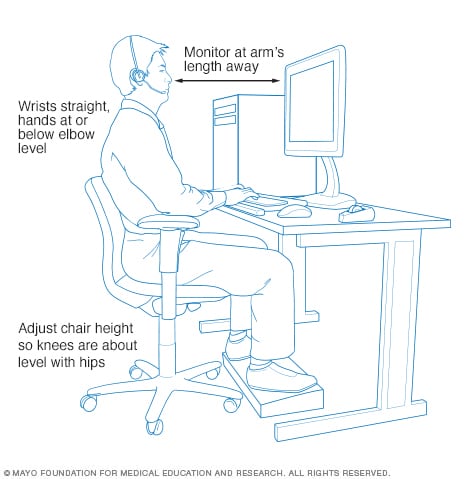Office ergonomics: Your how-to guide
Understanding office ergonomics and arranging your workspace accordingly can help you feel good throughout the workday.
By Mayo Clinic Staff
If your work involves sitting at a desk, discomfort doesn’t have to be part of the job. You may be able to avoid some of the health problems associated with seated work, such as neck and back pain and sore wrists and shoulders, by using proper office ergonomics. Chair height, equipment spacing and desk posture all make a difference.
Use this guide to ease stress on your body, protect your joints and help you stay comfortable as you work.

Chair
Choose a chair that supports your spine. Adjust the height of the chair so that your feet rest flat on the floor. Or use a footrest so your thighs are parallel to the floor. If the chair has armrests, position them so your arms sit gently on the armrests with your elbows close to your body and your shoulders relaxed.
Desk
Under the desk, make sure there’s enough room for your legs and feet. Don’t store items under your desk, as that can shrink the amount of available space and make it hard to sit correctly. If the desk is too low and the desk height cannot be changed, put sturdy boards or blocks under the desk legs to raise it. If the desk is too high and can’t be changed, raise your chair. Use a footrest to support your feet if necessary. If you don’t have a footrest, try using a small stool or a stack of sturdy books. If your desk has a hard edge that’s not rounded, pad the edge or use a wrist rest. This protects your wrists from a problem called contact stress that can occur as a result of extended contact with a hard edge.
Keyboard and mouse
Put your computer keyboard in front of you so your wrists and forearms are in line and your shoulders are relaxed. If you use a mouse or another type of pointer connected to a computer, place it within easy reach, on the same surface as your keyboard. While you are typing, using a computer touchpad, or using a mouse or pointer, keep your wrists straight, your upper arms close to your body, and your hands at or slightly below the level of your elbows. If possible, set the sensitivity of the mouse or pointer so you can use a light touch on it.
Monitors
Place the computer monitor straight in front of you, directly behind your keyboard, about an arm’s length away from your face. The monitor should be no closer to you than 20 inches (about 50 centimeters) and no further away than 40 inches (about 100 centimeters). The top of the screen should be at or slightly below eye level. If you wear bifocals, lower the monitor an additional 1 to 2 inches (about 2 to 5 centimeters) for more comfortable viewing.
Laptops
Using a laptop computer may lead to discomfort because of the low screen height and cramped keyboard and touchpad. If you use a laptop at your desk, consider getting an external keyboard and mouse, along with a laptop stand, to more closely mimic a desktop computer setup.
Frequently used objects
Keep objects you use often — such as the phone, stapler or printed materials — close to your body to minimize reaching. Stand up to get anything that you can’t reach comfortably while sitting.
Telephone
If you spend a lot of time on the phone, or if you often type or write while you’re using the phone, put the phone on speaker or use a headset. Don’t cradle the phone between your head and neck.
Remember, no matter how well your workspace is set up for proper ergonomics, sitting in the same position for hours at a time isn’t good for your body. Get up and walk around as often as you can throughout the workday. If possible, do some work standing up. While you’re seated, stretch your hands, fingers and arms from time to time. Shifting your position, standing up and moving will ease the strain on your body and help you stay healthier.
From Mayo Clinic to your inbox
Sign up for free, and stay up to date on research advancements, health tips and current health topics, like COVID-19, plus expertise on managing health. Click here for an email preview.
To provide you with the most relevant and helpful information, and understand which information is beneficial, we may combine your email and website usage information with other information we have about you. If you are a Mayo Clinic patient, this could include protected health information. If we combine this information with your protected health information, we will treat all of that information as protected health information and will only use or disclose that information as set forth in our notice of privacy practices. You may opt-out of email communications at any time by clicking on the unsubscribe link in the e-mail.
Thank you for subscribing!
You’ll soon start receiving the latest Mayo Clinic health information you requested in your inbox.
Sorry something went wrong with your subscription
Please, try again in a couple of minutes
May 25, 2023
See more In-depth
.
